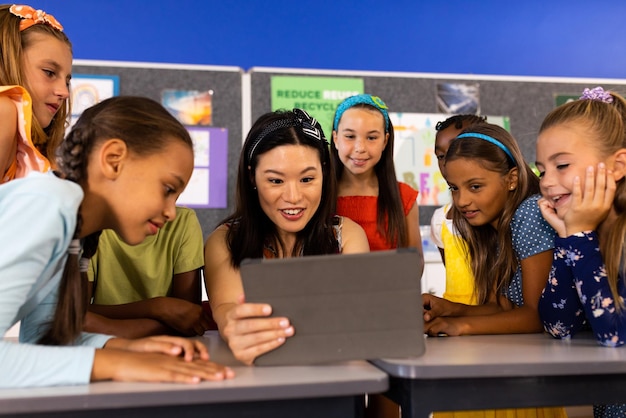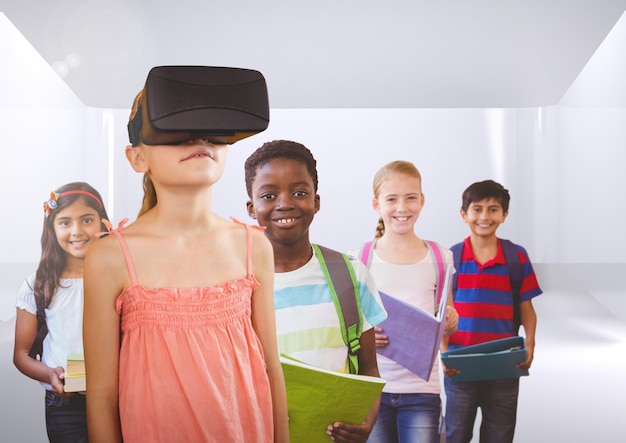Emerging Trends in EdTech: US Classroom Implementation

AD
Emerging trends in educational technology (EdTech) are revolutionizing US classrooms through personalized learning platforms, artificial intelligence applications, virtual and augmented reality, and enhanced data analytics, aiming to improve student engagement and outcomes.
The landscape of education in the United States is rapidly evolving, driven by the integration of new technologies. What are the emerging trends in educational technology and their implementation in US classrooms? This article explores the cutting-edge advancements transforming teaching and learning environments, and their potential to reshape the future of education.
AD
The Rise of Personalized Learning Platforms
Personalized learning platforms are becoming increasingly important in education, allowing students to learn at their own pace and in a way that suits their individual needs. These platforms use data analytics to assess student progress and adapt the curriculum accordingly. Let’s delve into how these platforms enhance the learning experience.
The adoption of personalized learning platforms marks a significant shift from traditional, one-size-fits-all educational models. By tailoring content and pacing to each student’s unique abilities and learning style, these platforms aim to maximize engagement and academic achievement.
AD
Adaptive Learning Technologies
Adaptive learning technologies are at the forefront of personalized learning. These systems continuously assess a student’s understanding and adjust the difficulty of the material accordingly. This ensures that students are always challenged but not overwhelmed, fostering a growth mindset and building confidence.
Benefits of Personalized Learning
Personalized learning offers numerous benefits, including increased student engagement, improved academic outcomes, and the development of self-directed learning skills. By providing a customized learning experience, students are more likely to stay motivated and achieve their full potential.
- Enhanced Engagement: Tailored content keeps students interested and invested.
- Improved Outcomes: Personalized pacing leads to better understanding and retention.
- Self-Directed Learning: Students learn to take ownership of their education.

Personalized learning platforms represent a significant shift in educational practices. While challenges remain in terms of implementation and equity, the potential benefits for students are undeniable. By embracing personalized learning, educators can create more engaging and effective learning environments.
Artificial Intelligence (AI) in Education
Artificial intelligence (AI) is rapidly transforming various sectors, and education is no exception. AI-powered tools are being developed to assist teachers, personalize learning, and provide students with instant feedback. Exploring the practical AI applications offers a glimpse into the future of education.
AI’s potential to reshape education lies in its ability to automate tasks, provide data-driven insights, and create personalized learning experiences. From intelligent tutoring systems to automated grading tools, AI is poised to revolutionize the way we teach and learn.
AI-Powered Tutoring Systems
AI-powered tutoring systems offer students personalized support and guidance. These systems can identify areas where students are struggling and provide targeted instruction and practice. This ensures that students receive the help they need to succeed.
Automated Grading and Feedback
AI can automate the grading of assignments and provide students with instant feedback. This frees up teachers’ time to focus on more important tasks, such as lesson planning and student interaction. Automated feedback can also help students identify their strengths and weaknesses.
- Personalized Support: AI tutors adapt to individual student needs.
- Efficient Grading: Automated systems save time and provide rapid feedback.
- Data-Driven Insights: AI helps identify areas where students need more help.
AI in education holds tremendous promise, but it’s important to address ethical considerations and ensure that these tools are used responsibly. By carefully considering the implications of AI, educators can harness its power to enhance teaching and learning.
Virtual and Augmented Reality (VR/AR) in the Classroom
Virtual and augmented reality (VR/AR) technologies are creating immersive learning experiences that were once unimaginable. By transporting students to virtual worlds or overlaying digital information onto the real world, VR/AR can enhance engagement and understanding. What are real-life applications of VR and AR in education?
VR/AR’s ability to create lifelike and interactive experiences makes it a powerful tool for education. From virtual field trips to interactive simulations, VR/AR can bring abstract concepts to life and make learning more engaging and memorable.
Virtual Field Trips
VR allows students to embark on virtual field trips to locations around the world. This can be a valuable tool for teaching subjects such as history, geography, and culture. Virtual field trips can also provide students with access to experiences that they would otherwise be unable to have.
Interactive Simulations
AR can overlay digital information onto the real world, creating interactive simulations that enhance learning. For example, students can use AR to explore the human body or to learn about different types of plants and animals. These simulations help students grasp complex concepts in an engaging way.
- Immersive Experiences: VR transports students to new worlds.
- Interactive Learning: AR overlays digital information onto the real world.
- Enhanced Understanding: VR/AR makes abstract concepts more concrete.

VR/AR technologies are transforming the learning landscape, creating opportunities for students to explore, experiment, and engage with content in new ways. While the cost of these technologies can be a barrier, the potential benefits for education are substantial.
Enhanced Data Analytics for Improved Outcomes
Data analytics is playing an increasingly important role in education, providing educators with insights into student performance and learning patterns. By analyzing data, educators can identify students who are struggling and provide them with targeted support. How does data collected impact educational outcomes?
The use of data analytics in education offers the potential to personalize learning, improve instruction, and enhance student outcomes. By tracking student progress, identifying areas of weakness, and providing timely interventions, educators can help students reach their full potential.
Tracking Student Progress
Data analytics tools can track student progress in real-time, providing educators with a clear picture of student performance. This allows educators to identify students who are falling behind and provide them with targeted support.
Identifying Areas of Weakness
Data analytics can also help identify areas where students are struggling. By analyzing student performance on assignments and assessments, educators can pinpoint specific concepts or skills that students are having difficulty with.
- Real-Time Tracking: Data provides educators with immediate insights into student performance.
- Targeted Support: Educators can identify and address areas of weakness.
- Informed Decisions: Data-driven insights improve instruction and enhance outcomes.
Ethical considerations and data privacy are important considerations when using data analytics in education. By addressing these concerns, educators can ensure that data is used responsibly and in a way that benefits students.
Gamification and Game-Based Learning
Gamification and game-based learning are emerging as powerful tools for engaging students and enhancing motivation. By incorporating game mechanics and elements into educational activities, educators can make learning more fun and rewarding. What are the core aspects and impact?
Gamification and game-based learning offer a unique approach to education, transforming traditional lessons into interactive and engaging experiences. By leveraging the motivational power of games, educators can foster a love of learning and improve student outcomes.
Incorporating Game Mechanics
Gamification involves incorporating game mechanics such as points, badges, and leaderboards into educational activities. These elements can create a sense of competition and achievement, motivating students to engage with the material.
Game-Based Learning
Game-based learning uses games as the primary vehicle for instruction. By playing educational games, students can learn new concepts and skills in a fun and engaging way. These types of games enhance content retention.
- Increased Engagement: Game mechanics make learning more fun and rewarding.
- Enhanced Motivation: Students are motivated to participate and achieve.
- Skill Development: Games can help develop problem-solving and critical-thinking skills.
The key to successful gamification and game-based learning is to carefully design activities and games that are aligned with learning objectives. By creating engaging and meaningful experiences, educators can harness the power of games to transform education.
Focus on Digital Equity and Accessibility
Digital equity and accessibility have become increasingly important considerations in education, particularly as technology plays a larger role in learning. Ensuring that all students have access to the technology and resources they need to succeed is essential for creating a level playing field. What does meaningful access and equity look like?
The importance of digital equity and accessibility cannot be overstated. Without access to technology and the skills to use it effectively, students from disadvantaged backgrounds are at risk of falling behind. Addressing these issues is crucial for ensuring that all students have the opportunity to thrive.
Providing Access to Technology
Providing access to technology includes ensuring that all students have access to computers, internet connectivity, and digital learning resources. This may involve providing laptops or tablets to students, offering free or low-cost internet access, and developing accessible digital content.
Developing Digital Literacy Skills
In addition to providing access to technology, it’s also important to develop students’ digital literacy skills. This includes teaching students how to use technology effectively, evaluate online information, and protect themselves from online risks. Digital skills are essential for success in the 21st century.
- Equal Opportunity: Digital equity ensures that all students have access to the tools they need.
- Future Readiness: Digital literacy skills prepare students for the workforce.
- Inclusive Education: Accessibility ensures that all students can participate in learning.
Addressing digital equity and accessibility requires a collaborative effort from educators, policymakers, and technology providers. By working together, we can ensure that all students have the opportunity to succeed in the digital age.
| Key Point | Brief Description |
|---|---|
| 🔑 Personalized Learning | Tailoring education to individual student needs for enhanced engagement. |
| 🤖 AI and Automation | AI tutors and auto-grading systems assist learners and educators efficiently. |
| 🌐 VR/AR Immersion | Virtual and augmented reality enhance learning through interactive experiences. |
| 📊 Data Analytics | Tracking and analyzing data to improve student outcomes and educational methods. |
Frequently Asked Questions
▼
EdTech provides personalized learning, real-time feedback, and access to a wide range of resources, making learning more engaging and effective. It also enriches the student outcomes by offering advanced learning apparatus.
▼
AI offers smart tutoring systems, automated grading, and tailored content delivery. This contributes to better learning and frees up educators to focus on students’ individual requirements, thus improving the students knowledge.
▼
VR and AR provide immersive experiences such as virtual field trips and interactive simulations. The immersive learning helps make complex subjects more understandable and engaging for students, enriching their understanding.
▼
Digital equity ensures all students have access to technology and digital literacy skills. Also, it helps provide and promote equal opportunities, and thus, preparing them for the modern digital arena, and world.
▼
Data analytics tracks students’ progress, identifies areas of weakness, and informs instructional decisions. It has been shown to enable the implementation of focused support, personalized approaches and improved outcomes in learning.
Conclusion
The integration of emerging technologies is set to transform US classrooms, offering unprecedented opportunities for personalized, engaging, and effective education. By embracing these advancements, educators can create learning environments that prepare students for success in the 21st century and beyond.